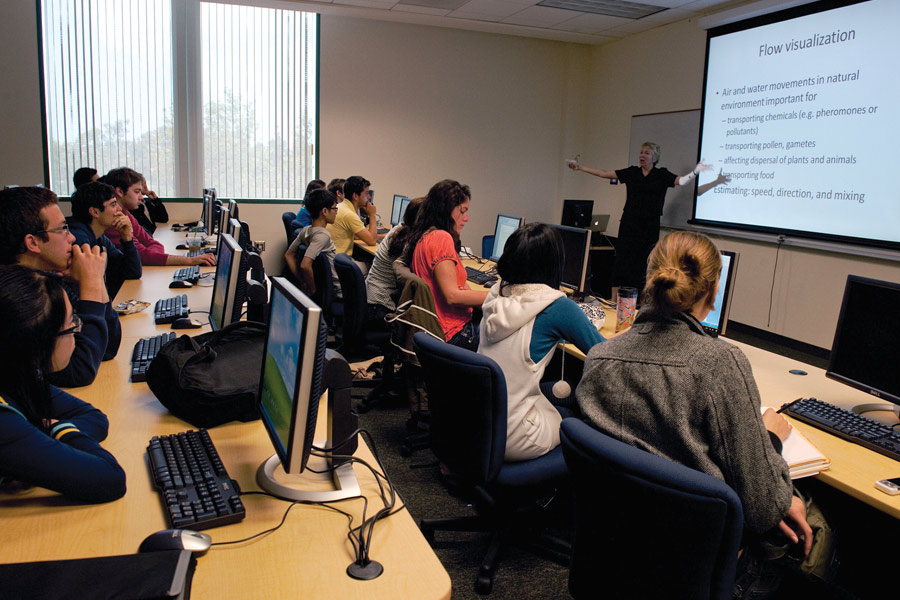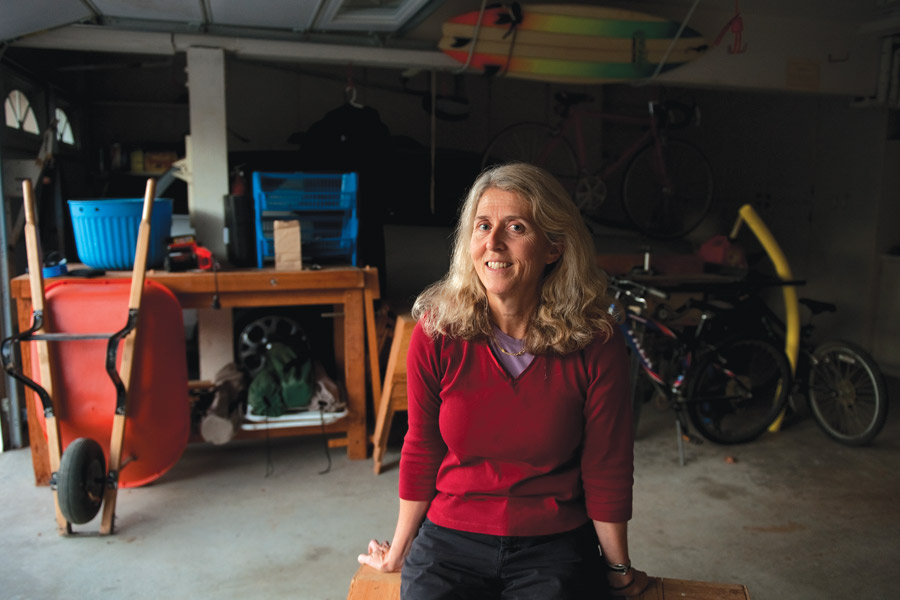
Unconventional instruction
Armed with bottles of bubble liquid, wands and video cameras, Catherine Loudon’s class gathers at a grassy area outside Steinhaus Hall. Their assignment: Cast bubbles to the wind.
It’s not playtime. Loudon, a UCI lecturer in ecology & evolutionary biology, is showing her biology students an important concept: flow visualization. They will try to understand otherwise invisible air and water movements.
Complicated words in a stuffy classroom instead become a vivid lesson in how insects follow pheromone plumes.
Loudon is just one example of UCI instructors going beyond the traditional lecture. The focus now is on active learning, interacting with students and helping them develop problem-solving skills.

“The bubbles show how the wind shifts, dies down, starts again,” says Loudon, who has taught at UCI for a decade. “It’s not easy to follow. But it’s important because this is how insects and many other creatures communicate.”
Later, students will analyze the data they collect, comparing the differences between following visual and chemical cues in the environment.
“Learning is not just a set of facts to memorize,” Loudon says. “It’s thinking creatively, learning how to deal with new situations.”
She also teaches a freshman seminar on biomimetic design through the Division of Undergraduate Education in which small groups of students are broken out for special projects. A similar program through the Francisco J. Ayala School of Biological Sciences that will include all freshman biology majors is scheduled to start in fall 2017.
“Learning is not just a set of facts to memorize. It’s thinking creatively, learning how to deal with new situations.”
“It’s giving students a chance to be exposed to research with a faculty member, which they otherwise might not experience until their junior or senior year,” Loudon says, adding that UCI’s emphasis on innovative teaching and learning techniques has always been strong, “but in recent years, it has really stepped up.”
Ngoctran Tran, a junior biology major, agrees. She says her professors have become more inventive, citing quizzes on which Loudon encourages student collaboration.
“Solving problems in class gets me more engaged, instead of just listening to the professor and only remembering so much,” Tran says.
Garage Demos

When Diane O’Dowd wants to improve her teaching, she heads for the garage. That’s where the UCI professor of developmental & cell biology finds the raw materials for explaining the mysterious world inside a cell.
Tennis balls, soccer socks, Styrofoam, old Halloween costumes – anything is fair game when you’ve got to show a lecture hall of 440 students something they can’t see: tiny, complex processes that make life possible.
O’Dowd calls her creations “garage demos,” large props that student volunteers manipulate in class to drive a point home. A garbage bag, for example, depicts how a proteasome (a cell’s “garbage disposal”) breaks down a damaged protein, ejecting peptides (sliced-up pipe insulation) that are recycled to build new proteins.
Her teaching transformation began in the early 2000s, as O’Dowd’s own two children were starting college. She had the uncomfortable feeling that her kids “wouldn’t enjoy my classes very much.”
So she experimented with new methods, interacting more with her students. She handed out colored cards to hoist as answers to questions she tossed out during lectures. The answers helped her to gauge their understanding. Cards later gave way to clickers, which project an instant tabulation on the screen.
A grant from the Howard Hughes Medical Institute led to her garage demos. “I would think, ‘Here’s a problem my students are having, and how do I explain it?’” O’Dowd says.
Not only do her students understand the material better, but she enjoys the more interactive style of teaching too, calling it “more intellectually challenging” than just giving lectures.
She has spread the gospel of garage demos to other UCI professors, many of them happy to discard the old ways. The demos are recorded and uploaded to YouTube so students can review them later. O’Dowd also offers tips that other professors can use to enhance their presentations, such as starting with a PowerPoint lecture to get students acquainted with the basics before the demo gives a visual explanation.
In addition, she started “flipping classes” long before it was called that. The idea: Students watch video lectures online at home, learning the new material at their own pace. In class, they work on related exercises, the teacher scanning the room for students needing help. O’Dowd says she only “partially flipped,” because she still occasionally used in-class lectures.
There’s another reason professors are updating their methods. Students in biology and other STEM (science, technology, engineering and math) programs too often quit and switch to less rigorous majors. O’Dowd and other UCI instructors believe that their techniques lead to better student understanding, resulting in higher grades and providing the confidence that they chose the right majors.
O’Dowd, who has also served as vice provost for academic personnel for the past two years, continues to push her ideas on active learning, making sure that faculty evaluations take commitment to teaching into account.
Plus, she says, many professors are realizing that teaching can be more closely aligned with their research. “They aren’t mutually exclusive,” O’Dowd says. “Faculty find this to be a much more interesting way of teaching.”
Mixing Up Media
Keith Murphy, UCI associate professor of anthropology, revels in bringing an unorthodox approach to his courses, adapting to how the younger generation works.
“Students often switch between different media as they study,” he says. “They sit down, read a PDF and, in another window, watch Netflix. They process information very differently than we do, using a lot of videos from YouTube. Rarely do I use academic media; I use commercials and news stories. I try to reach them through stuff they can relate to.”
“Students often switch between different media as they study. They sit down, read a PDF and, in another window, watch Netflix.”
Instead of PowerPoint, Murphy prefers Apple’s Keynote because, he says, it makes it easier to embed videos into his lectures, which he often does.
“Students say they really like the way I present information,” says Murphy, whose innovative teaching techniques were a major factor in his selection as UCI’s 2016 Professor of the Year. “It’s not just slides and lists.”
He even takes it a step further, incorporating improv into a class on how people communicate.
“The rules for improv are really social theories,” says Murphy, who wrote, performed and directed improv while an undergraduate at the University of Chicago, before the demands of academia forced him to give it up.
As his students practice scenes and learn the rules of improv, they understand better how humans communicate – and become better communicators themselves.
Digital Learning
Mark Warschauer taught his first class shortly after Jimmy Carter was elected president.
“It was 1977, so you do the math,” jokes Warschauer, who was originally a bilingual math and ESL instructor in San Francisco. His journey as a teacher, researcher and administrator took him to Hawaii, Moscow, Prague, Japan and Egypt before he arrived at UCI in 2001, becoming a professor of education and informatics, interim dean of the School of Education and founder of the Digital Learning Lab.
Warschauer and his colleagues are pursuing a broad range of all studies on digital learning. UCI teachers use many of the strategies: student interaction, problem-solving, flipped classrooms. Research is confirming their effectiveness, especially with first-generation college students.
High-tech initiatives include ALEKS, an online tutoring and assessment system developed at UCI in the 1990s. It provides automated help in precalculus, algebra and other subjects. “Students are getting better results than they did before,” Warschauer says.
Still, online classes – in which students rarely or never meet the professor or their classmates – often are plagued by high dropout rates and low scores. “They demand a lot of self-regulation by the student,” Warschauer cautions, adding that a new summer program is sending students periodic emails nudging them to schedule homework and other tasks.
“It’s one of several studies we’re working on,” he says. “We’re trying to find patterns – what is working and what is not.”
Massive open online courses have proven helpful for biology students who need a boost before they start at UCI. Offered in the summers of 2013 and 2014 thanks to grant funding, the MOOCs “covered basic information about biology that students should have before they start. They found it to be very helpful,” Warschauer says.
But whatever technological advances the future holds, there will always be a need for the human touch.
“Interaction is the key,” Warschauer says. “It’s stopping to work on problems and interacting with students. We know that works.”
Video: http://bit.ly/ucimag_fall2016_GarageDemos
-John Westcott, UCI


